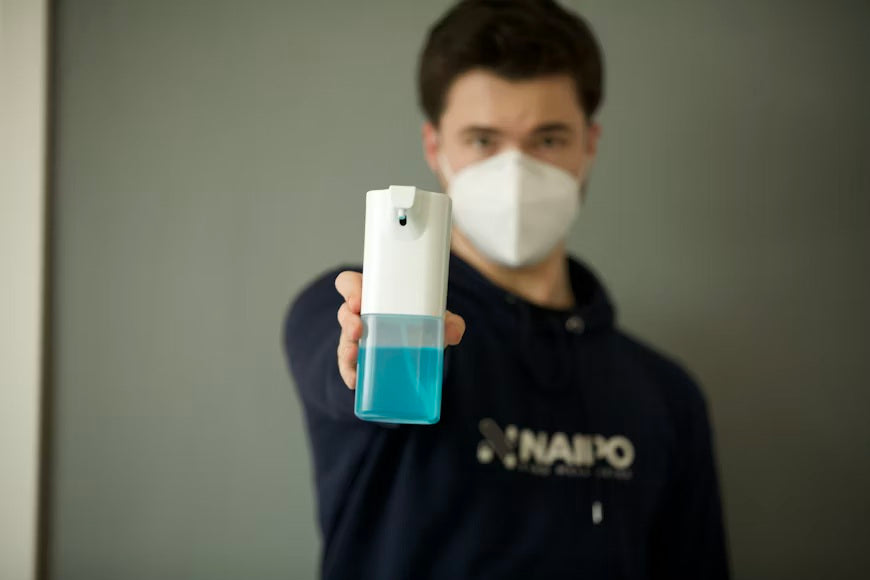
What is the role of textile protector after cleaning?
Share
Dutch households owe a great deal to professional carpet and furniture cleaners. They know that the job isn't truly finished until a fabric protector has been applied. This simple yet powerful product plays a crucial role in extending the life of textiles and preserving their appearance.
In this article, we explain exactly what a fabric protector does, how it works, and why professionals use it after every cleaning.
What is textile protector?
Fabric protector is an after-treatment applied to carpets, rugs, furniture fabrics or other soft furnishings after cleaning.

It works by creating an invisible barrier on the surface of the fibers, which helps to:
- Liquid repellency
- Preventing stains
- Reducing wear and tear
- Facilitate future cleaning
These sprays are usually formulated with fluoropolymers or silicone compounds, which bond to the fibers without affecting the texture or color of the material.
Why apply after cleansing?
Applying fabric protector immediately after cleaning is most effective for several reasons:
- Clean fibers provide better adhesion – Once dirt and oils are removed, the protector can bond directly to the fiber, creating a uniform barrier.
- Prevents immediate re-soiling – After professional cleaning, unprotected fabrics are vulnerable to new spills or dirt. A protector protects against this.
- Improves the longevity of results – It extends the freshness and appearance of the cleanse, giving customers a greater experience of value and satisfaction.
Simply put, a cleaning job without a protective finish is only half done.
How does textile protector work?
The primary function of a fabric protector is to coat fibers with a microscopic shield. This shield repels both oil- and water-based contaminants that would otherwise penetrate the fabric and cause stains.
When a liquid is spilled on a treated surface, it beads up instead of soaking in. This gives homeowners or cleaning crews time to blot it up before it causes permanent damage.
In addition, dirt and dust are less likely to adhere to the protected surface, which helps to maintain a cleaner appearance for longer.
Benefits of using fabric protector
1. Stain prevention
This is the main reason professionals use fabric protectors. They help prevent:
- Coffee, wine or soft drink stains
- Pet accidents
- Mud or dirt from shoes
- Ink or color transfer
By preventing absorption, these sprays make stains much easier to blot or clean later.
2. Longer lifespan of carpet and furniture upholstery
Stains, moisture, and embedded dirt are major causes of fiber breakdown. A fabric protector acts as a buffer, reduces friction, and limits damage from daily use. This leads to longer-lasting furniture and floors.
3. Easier future cleaning
Treated fabrics retain dirt less easily. When the next cleaning is performed, there's less buildup to remove, which means:
- Faster cleaning times
- Less need for aggressive chemicals
- Better long-term results
4. Odor control
Some protective sprays contain deodorizing agents or prevent spills from seeping into the upholstery, which can otherwise trap odors. This is especially helpful in homes with pets or children.
Where can you use fabric protector?
textile protector can be used on:
- Carpets (residential or commercial)
- Upholstered furniture (sofas, chairs, poufs)
- Car interiors and floor mats
- Rugs
- Desktop panels
- Curtains and fabric-covered walls
It is especially useful in high-traffic areas or places prone to accidental spills, such as dining rooms, waiting rooms, or family rooms.
Professional use versus DIY application
While fabric protectors are available in stores for home use, professional products:
- More concentrated
- Applied with commercial equipment for even distribution
- Designed to last longer and withstand heavier wear and tear
Professional cleaners often apply protectors as part of a complete service package, offering it as an upsell or included benefit. Customers may not realize how important this step is until they experience fewer stains and easier maintenance.
How long does it last?
The lifespan of a textile protector depends on several factors:
- Fiber and fabric type
- Amount of foot traffic or usage
- Frequency of vacuuming and maintenance
- Type of protector used (silicone vs. fluorocarbon)
In general, most protectors last 6 to 12 months in high-traffic areas and up to 18 months in less-used areas. Professionals recommend reapplying them after each deep cleaning to maintain the protection.
Common myths about fabric protectors
“It changes the feel of the fabric.”
High-quality sprays are designed to leave no residue or noticeable texture. When applied correctly, you won't even notice it's there.
“It is not necessary after cleaning.”
In reality, cleaning removes previous protective layers. Without reapplying, the carpet or furniture remains vulnerable to stains.
“It's only for expensive fabrics.”
Every fabric can benefit from extra protection, whether it's a luxury sofa or a standard office carpet. Protection means a longer lifespan.
Final thoughts
Fabric protector isn't just a luxury addition; it's a practical tool for maintaining the results of any carpet or furniture cleaning. By creating an invisible barrier against moisture, oils, and dirt, fabrics stay fresh, clean, and new for longer.
For professional cleaners, offering textile protection improves service quality and increases customer satisfaction. For homeowners and business owners, it's an investment that pays off in lower maintenance costs and a longer lifespan for valuable furnishings.
